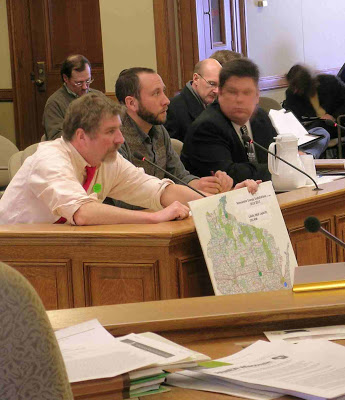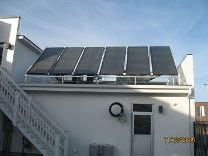by jboullion | Feb 22, 2010 | Uncategorized
From the newsletter of Energy Concepts, Hudson, WI:
Wisconsin residents have their own “perfect storm” solar incentive brewing: the combined credits from Focus on Energy, the Federal tax credit and the State Energy Efficient Appliance Rebate Program (SEEARP) can reduce the cost of a solar hot water system by over 50%.
Let’s tote them up:
• Focus on Energy will support qualifying solar thermal systems up to $20 a therm, to a maximum of $2,750 per system.
• SEEARP, which is actually a Federal program initiated under the 2009 Recovery and Reinvestment act, will reimburse the same system up to $2,000.
• The Federal 30% tax credit can be applied to the balance of the installation cost.
A sample cost worksheet might look like this:
Installation cost: $11,000
Focus Rebate: $2,250
SEEARP: $2,000
Federal Credit: $2,025
Total Credits: $6,275
Final Cost: $4,725
Price reduction on system: 57%
This does not include possible MACRS depreciation recapture should the system be installed in a business–that could shave another 10%–15% from net system cost.
How much energy savings accrue annually is dependant on how much hot water is consumed and what the price of gas or electricity is in your area.
But, solar hot water is known to produce the shortest payback period in the renewable energy industry. It would not be wild speculation, given energy inflation, to say that the above system would pay back in under 10 years.
With State PV incentives of just $1.25 a watt, Wisconsin residents might feel jealous of Minnesota’s new PV incentives. But the best response would be not to get mad, but to get even. And right now, that means installing solar hot water sytems in the Badger State, understanding that renewable energy’s quickest payback period just got a lot quicker.

by jboullion | Feb 3, 2010 | Uncategorized

Michael Vickerman (left), Josh Stolzenburg (center), owner of North Wind Renewable Energy, LLC, Stevens Point, and Dave Miller, Wave Wind, LLC, Sun Prairie, testify in support of the Clean Energy Jobs Act bill before the Special Assembly Committee on Climate Change. Vickerman leans forward to show the committee members a map of renewable energy installations.
From a summary of Michael Vickerman’s (RENEW Wisconsin)
testimony before the Assembly Special Committee on Clean Energy, February 2, 2010:
RENEW Wisconsin strongly supports the provisions in SB450/AB649 to expand the state’s Renewable Energy Standard to 25% by 2025, which includes a 10% in-state renewable energy set-aside. RENEW has evaluated the availability of specific resources to reach that standard and has concluded that meeting such a target is technically feasible. If adopted, the in-state set-aside will become the most powerful engine for job development and capital investment over the next 15 years.
We expect such a requirement to be achieved through a combination of utility-scale power plants and smaller-scale generating units dispersed throughout Wisconsin. With respect to distributed renewable generation, we note the following:
1. The vast majority of the distributed renewable generating units installed in Wisconsin serve schools, dairy farms and other small businesses, churches and local governments.
2. Utilities are not in the business of installing these systems themselves.
3. In many cases the renewable energy installation went forward because there was a special buyback rate available to accelerate the recovery of the original investment made by the customer. Last week, I gave the example of the Dane County community anaerobic digester project that, once operational, will treat manure taken from several nearby dairy farms in the Waunakee area and produce two megawatts of electricity with it. The electricity will be purchased by Alliant Energy through a voluntary biogas tariff worth 9.3 cents/kWh. Unfortunately, Alliant’s biogas program is fully subscribed and is no longer available to other dairy farmers, food processing companies and wastewater treatment facilities served by Alliant.
4. Companies that install solar, wind and biogas energy systems are quintessentially small businesses, many of them family-owned. Renewable energy contractors and affiliated service providers constitute one of the few market sectors where young adults who have acquired the necessary skills to do the job well can find meaningful work at decent pay.
5. By its very nature, distributed renewable energy delivers nearly 100% of its economic punch to the local economy.
by jboullion | Jan 28, 2010 | Uncategorized
From a news release issued by Clean Wisconsin:
OSCEOLA, WI — It’s never too early to teach people about energy efficiency, and in Osceola, students and community members are getting a firsthand education. By adding solar panels and thermal blankets to the middle school’s pool complex, the district has saved taxpayers $32,500 annually.
A prior energy review showed Osceola’s four schools were responsible for more than 70 percent of the energy used by the community’s public buildings. The solar panels and thermal blankets added to Osceola’s middle school pool complex in 2008 have reduced its energy usage by a remarkable 96 percent, saving $32,500 per year. The thermal blankets also reduced evaporation from the pools, saving 20,000 gallons of water per month. That’s one less day of pumping from village wells each year. Plus, it reduces the amount of pool chemicals used and how long dehumidifiers must run.
“We were pleasantly surprised by the cascade of benefits and savings from the pool project,” said Osceola energy coordinator and school board president Timm Johnson. “We hope that our experience is something that other schools, YMCAs and other institutions with pools are able to learn from and apply to their particular situations.”
And now, school officials and residents are eager for more. On January 26, the village and school boards met jointly to discuss next steps, including increasing their energy efficiency, renewable energy options and sustainability efforts. Osceola officials also agreed to consider making the village an “eco-municipality.” Nearly 30 communities across Wisconsin have already passed eco-municipality resolutions, which establish a sustainability framework to evaluate and improve policies and practices. The school and village boards are also inviting the public to a February 18 meeting, where community members can learn how they can become involved.

by jboullion | Jan 19, 2010 | Uncategorized

From a post on the Web site of Bubbling Spirngs Solar:
Café 27 in Steven’s Point has just finished the installation of a six-panel array of Bubbling Springs Solar’s collectors, performed by Bob’s Plumbing. Using solar thermal technology in the foodservice industry is highly economical; the sun heats or preheats the water for dishwashing and cooking, cutting down on conventional energy bills. Café 27 is setting an excellent example and we hope to see more solar thermal in the foodservice industry. Check out Café 27 at 945 Clark St. in Stevens Point, WI or call 715-544-4730.
by jboullion | Jan 15, 2010 | Uncategorized
From an article by Julie Lawrence at OnMilwaukee.com:
Back in spring 2008, Pragmatic Construction, a Milwaukee-based green construction company aimed at advancing the principles of sustainable development within the urban environment, was knee-deep in a series of development projects but was still planning its path for a greener future in Milwaukee.
Co-founder Steve Servais and his crew were just laying out the plans for two single-family homes in Riverwest that were slated to be among the state’s first LEED (Leadership in Energy and Environmental Design) certified platinum homes. . . .
LEED-certified buildings are designed to lower operating costs and increase asset value, reduce waste sent to landfills, conserve energy and water, be healthier and safer for occupants and reduce harmful greenhouse gas emissions.
Two years later, the side-by-side sustainable homes at 702 and 708 E. Hadley St. are complete and now on the market. Servais says his company has really pushed sustainable building to the limit.
The house sizes are modest; 1,200 and 1,300 square feet, respectively. But the environmental impact is huge. Some of the many green features include passive solar heating, passive cooling, 96 percent energy-efficient forced-air backup HVAC, bio-based sprayfoam roof insulation, triple-pane windows, tankless hot water, reclaimed hardwood flooring, reclaimed doors, steel, fiber-cement and cedar siding, stained concrete flooring, no-VOC paints and finishes, dual-flush toilets and low-flow fixtures, in-floor radiant heat and energy recovery ventilators.
And it doesn’t stop indoors. Outside they’ve implemented rain barrels, a shared rain-garden, pervious paving surfaces, steel roofing, recycled plastic roofing, a 2.1KW PV Array (solar electric), and two flat-panel solar hot water arrays.


